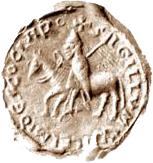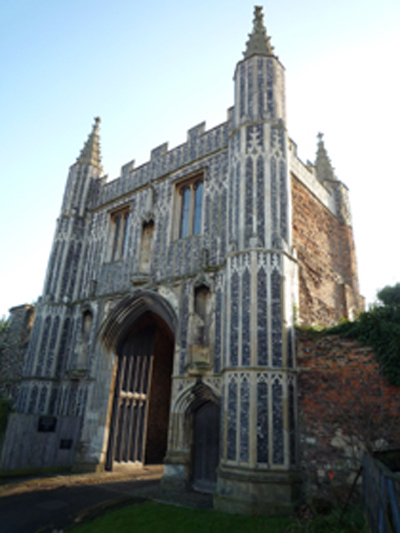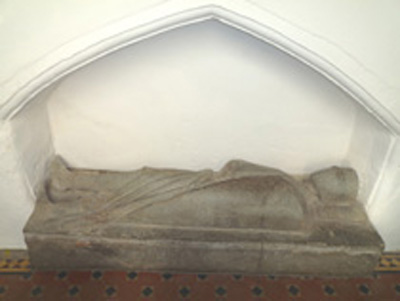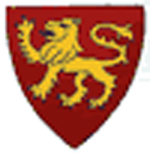The Lanvalei family
William (I)’s marriage to Gunnore, Hubert de Saint Clair’s only child and a ward of the king, brought with it considerable lands, although Henry granted Eaton Socon in Bedfordshire to Hugh de Beauchamp. This became the subject of a grand assize in 1201, when William (II) petitioned that Eaton Socon and Sandy ought to descend to him because Hamo de Saint Clair held them at the death of Henry I, but it must have found in Hugh’s favour.William (I) de Lanvalei was one of Henry II’s ‘new’ men. It is likely that he came from the vill now called Lanvallay in Brittany, and was supporting Henry before he arrived in England with or soon after the king. William was accounting for danegeld and witnessing charters in England and Normandy as early as 1155-56. It also seems likely that he was accompanied by a brother, Ralph de Lanvalei, who was recorded in Brittany in 1154. Ralph was granted the fee-farm of Shaftesbury in Dorset from 1156 until 1163, after which it was held by William and, later, his son William (II) de Lanvalei.
Clearly William (I) was an able administrator and closely involved in Henry’s administration. He was present at the important meeting at Clarendon with Henry and his son in 1164. The king appointed him seneschal in the county of Rennes in Britanny between 1166-71, presumably because of his knowledge of the area. After his return, he was castellan at Winchester castle from 1171 to 1174. In 1175, the king appointed him and Thomas Basset as his royal justices to hear pleas at ordinary assizes, which included twelve counties in their eyre (circuit). In 1176, the fee-farmer of Southampton charged the king for the use of ships by his Embassies, including one by William.
Although William had the choice of a number of manors to reside at while he was in England, from 1169 he was referred to as William de Lanvalei of Henherst in Kent, which must have been an estate granted to him by Henry. He died in 1180, leaving two sons, William (II) and Ralph, possibly a third son, Oliver, and one daughter, Gunnora. William (II) married Hawise, the daughter of Hugh de Boclonde, and Gunnora married William de Beauchamp.
After holding the fee-farm of Shaftesbury, William’s brother Ralph is next recorded at Blacgrave and Lambourn in Berkshire, with an interest in nearby Estbury. It seems likely that Ralph died childless and his lands passed to his brother, which later caused disputes between William’s two sons. William (II) obtained Estbury in 1194, but his brother (the younger Ralph) held Blacgrave until a successful claim by William (II) in 1197. Ralph died in 1209, holding Estbury, and was succeeded by his daughter Maud. She was a minor and became a ward of king John, who in 1211 married her to Richard Walen (de Waleys) of Winterbourne and Upper Lambourn. In 1211, the sheriff was ordered to grant Blacgrave to Richard Walen, claimed in the right of his wife, but William (III) must have retained them, because his daughter and her husband John de Burgh held the overlordship in 1240.
William (II) was appointed governor of Colchester castle in 1196. Unlike Hamon and Hubert de St. Clare, he did not hold the post as a hereditary entitlement, and in 1200 purchased the right of custody from king John. He died in 1204, after which he was succeeded by Hawise and then his son, William (III). It was this William de Lanvalei who was one of the twenty-five Magna Carta sureties appointed by the barons at Runnymede in 1215. William was dispossessed of Colchester castle by the king in November 1214, but it was ordered to be returned to him after July 1215, becoming one of the few royal castles to be in the hands of the barons. However, by October, William was in rebellion and he lost the castle again. By 1217 he had died.
William (III) married Matilda Pecche, the daughter of Gilbert Pecche, and they had one daughter, Hawise, who was a minor when William died. Ironically, it was Hubert de Burgh, seneschal of Poitou, justiciar for England and one of the knights supporting king John at Runnymede, who took Hawise as his ward, presumably after making a payment to the king.
With William’s death, the male line of the Lanvalei family ended and the barony of Lanvalei passed to the Burgh family. Their appearance in England had lasted for just over sixty years. They were not Anglo-Norman magnates with vast wealth and lands, but a new breed of administrators who changed the country for ever.
See Medieval Walkern and Magna Carta, a book about the history of Saint Clair and the Lanvalei families, and The Magna Carta Barons.
| 1 | 2 | 3 | 4 | 5 | 6 | 7 | generations | ||||||
| Hamo de Saint Clair (c.1099-c.1155) | |||||||||||||
| m. (2) Margaret (-1150), dau. of Robert FitzWalter of Horsford and Avelina FitzFlaad | |||||||||||||
| m. (1) Gunnor Bigod | |||||||||||||
| Hubert de Saint Clair (c.1120-1155) m. Clemence de Clare (1125-1205) | |||||||||||||
| Gunnore de Saint Clair (c.1143-) m. William (I) de Lanvalei (c.1125-1180) | |||||||||||||
| William (II) de Lanvalei (c.1161-1204) m. Hawise de Boclonde | |||||||||||||
| William (III) de Lanvalei (c.1182-c.1217) m. Matilda Pecche, dau. of Gilbert (or Hamon) Pecche | |||||||||||||
| Hawise de Lanvalei m. before 1227, John de Burgh (1209/14-before 1278), son of Hubert de Burgh | |||||||||||||
| Oliver de Lanvalei (fl.1187) | |||||||||||||
| Gunnora de Lanvalei m. 20 June 1207, William de Beauchamp (-1260), son of Simon de Beauchamp and Isabella | |||||||||||||
| John de Beauchamp (-before 1232) | |||||||||||||
| Ralph de Lanvalei of Eastbury, Berks m. not known | |||||||||||||
| Maud de Lanvalei, fl.1246 | |||||||||||||
| m. (1) 1211, Richard de Waleys of Winterbourne and Upper Lambourn | |||||||||||||
| Richard de Waleys, fl.1246, d. a minor | |||||||||||||
| Ralph de Waleys of Eastbury and Winterbourne (-1249/50) | |||||||||||||
| John de Mareys (-1265) m. before 1249/50, Agnes | |||||||||||||
| John de Mareys m. unknown, 4 daughters | |||||||||||||
| Juliane de Lanvalei (-1283) m. before 1249/50, Geoffrey de Wrokeshale or Wroxhale, kt. | |||||||||||||
| Eustace de Wrokeshale, d.s.p. m. Wenthlian (-1301) | |||||||||||||
| Joan (-1302) m. Henry de Cerne, kt., of Draycote (-1296), issue 1 son | |||||||||||||
| Rohese (-1292) m. Richard de Brokenesbergh or Brokesbergh, issue 1 son | |||||||||||||
| Anastace (-1302) m. John de Haddon of Caundle Haddon (-1302), issue 1 son | |||||||||||||
| Margaret or Margery, fl.1333 m. Geoffrey de Mohun of Adber, fl.1313, issue 1 son | |||||||||||||
| m. (2) before 1230, Gilbert de Mareys, fl.1242 | |||||||||||||
| Agnes de Lanvalei, d.s.p. 1252 | |||||||||||||



